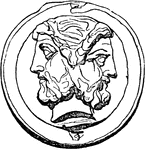Clipart tagged: ‘As’

Flag of American Samoa, 2009
Color flag of American Samoa. Blue, with a white triangle edged in red that is based on the fly side…

Flag of American Samoa, 2009
Black and white outline flag of American Samoa. Blue, with a white triangle edged in red that is based…

As
"The unit of value in the Roman and old Italian coinages, was made of copper, or of the mixed metal…

As
"The unit of value in the Roman and old Italian coinages, was made of copper, or of the mixed metal…